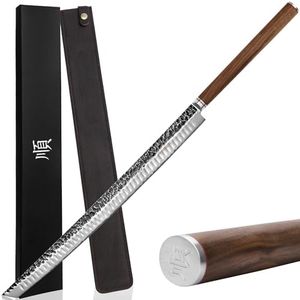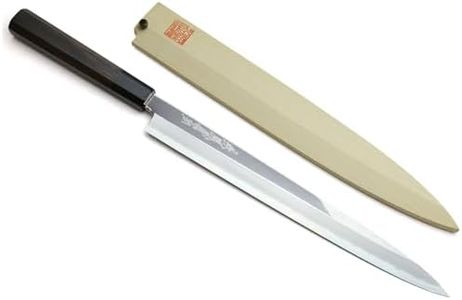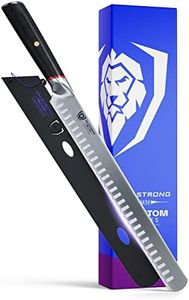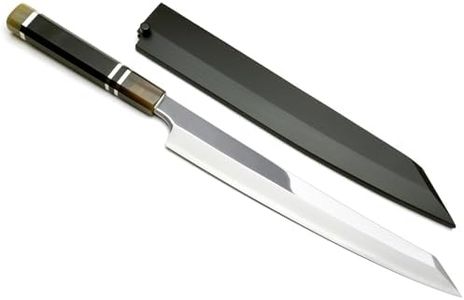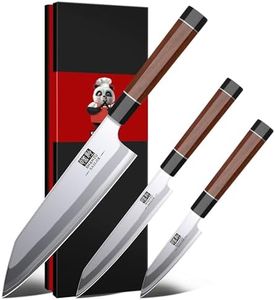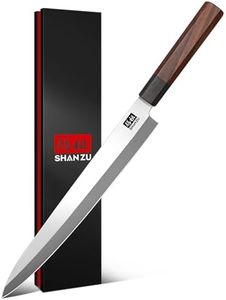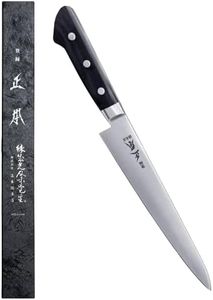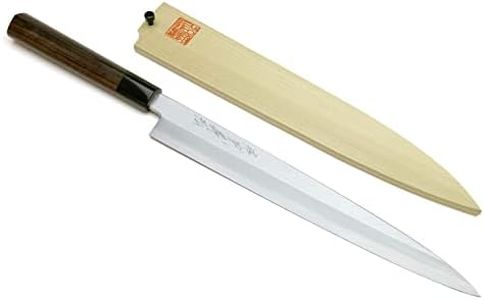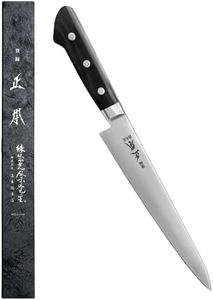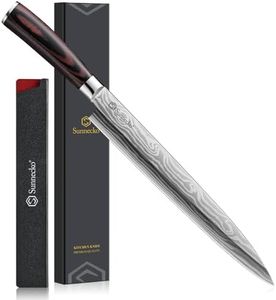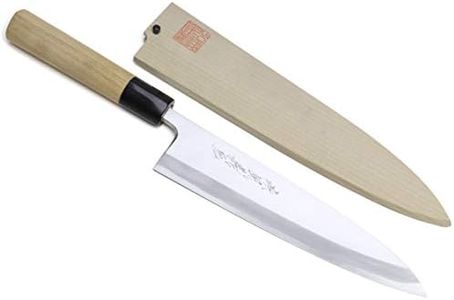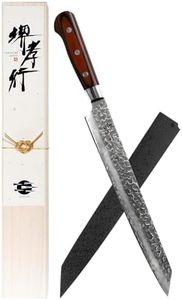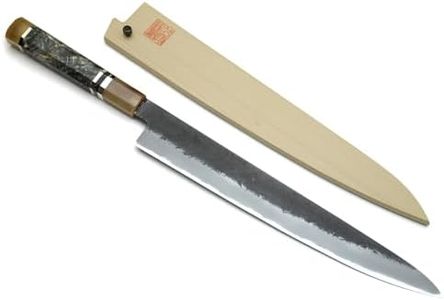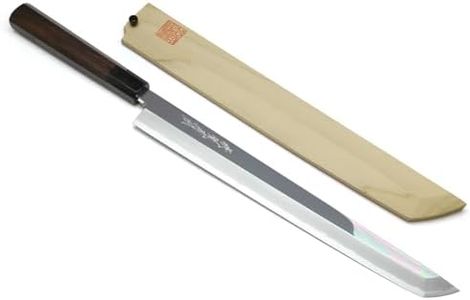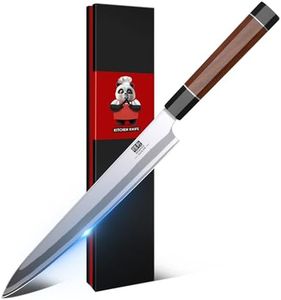10 Best Sashimi Knives 2025 in the United States
Our technology thoroughly searches through the online shopping world, reviewing hundreds of sites. We then process and analyze this information, updating in real-time to bring you the latest top-rated products. This way, you always get the best and most current options available.

Our Top Picks
Winner
Yoshihiro Ginsan Mirror Polished Stain Resistant Steel Yanagi Sushi Sashimi Japanese Knife Ebony Handle(11.8"(300mm))
Most important from
4 reviews
The Yoshihiro Ginsan Yanagi Sashimi Knife is a top choice for those serious about slicing sushi and sashimi. Its 11.8-inch blade is made from Ginsan stain-resistant steel, which combines the sharpness of traditional high carbon steel with resistance to rust and stains, offering a great balance for kitchen use. The single-edged, mirror-polished blade is designed for clean, precise cuts that maintain the texture and freshness of delicate fish without tearing. The yanagi blade shape, known for its long, thin profile, allows for smooth slicing in long strokes, ideal for sashimi presentation. The handle is made from ebony wood and shaped in an ergonomic octagonal style, providing a comfortable, secure grip and good balance, making the knife easier to control during use.
This knife requires careful maintenance: it must be hand-washed and dried immediately after use and sharpened with water whetstones to keep its edge and quality intact. It is not dishwasher safe and should not be used on hard items like bones or frozen foods to avoid damage. The inclusion of a traditional magnolia wood sheath (Saya) helps protect the blade when stored. Handmade in Japan by skilled artisans, this knife combines uniqueness and quality. For those willing to invest time in its care, the Yoshihiro Yanagi offers excellent performance and beauty, but it may not be suitable for users seeking low-maintenance knives or those who need a tool for tougher kitchen tasks.
Most important from
4 reviews
Dalstrong Ultimate Slicer Sujihiki Knife - 10.5 inch - Shogun Series ELITE - The Tokugawa - Damascus Slicing Knife - AUS-10V Japanese Super Steel Kitchen Slicer Saya - Kitchen Knife - Sheath Included
Most important from
1811 reviews
The Dalstrong Ultimate Slicer Sujihiki Knife is a high-quality kitchen tool designed for precise slicing, making it suitable for sashimi enthusiasts who want thin, clean cuts. It features a 10.5-inch blade made from AUS-10V Japanese super steel, known for its excellent sharpness and edge retention thanks to its 62+ Rockwell hardness. The blade is crafted with 67 layers of high-carbon stainless steel, adding strength and resistance to stains and corrosion. Its shape includes a slightly curved belly and a narrow tip, which helps with maneuverability and fine slicing tasks.
The handle is made of Ultra-G-10, a durable fiberglass material that resists heat, moisture, and cold, offering comfort and control during use. The knife is well balanced and lightweight, promoting agility without fatigue. It is not dishwasher safe, so hand washing is necessary to maintain its quality.
Primarily marketed as a slicer for various foods, its precision and design also make it a good fit for sashimi slicing. Users generally find the balance excellent. For those looking for a durable, sharp, and comfortable slicer with professional-level performance, this Dalstrong knife is a solid choice.
Most important from
1811 reviews
Yoshihiro Ginsan Mirror Polished Stain Resistant Steel Yanagi Sushi Sashimi Japanese Knife Ebony Handle(10.5"(270mm))
Most important from
4 reviews
The Yoshihiro Ginsan Yanagi sashimi knife is crafted in Japan with a 10.5-inch blade made of Ginsan stain-resistant steel. This material blends traditional high-carbon sharpness with modern rust resistance, making it both sharp and easier to maintain than typical carbon steel knives. The single-edged Yanagi blade has a slender, long shape designed specifically for slicing raw fish with very clean, thin cuts that keep the fish’s texture and flavor intact. The blade’s mirror polish and special grindings (flat front and concave back) help reduce friction and prevent damage to delicate sashimi slices.
The handle is made of ebony wood and shaped in a traditional octagonal style, which fits comfortably in the hand and provides good control during precise slicing. The knife is lightweight and well-balanced, allowing smooth, uninterrupted slicing motions. It also includes a wooden saya sheath for safe storage. However, this knife requires careful maintenance: it should be hand-washed immediately after use and sharpened with water whetstones only. It’s not dishwasher safe and is not suitable for cutting hard items like bones or frozen foods.
This knife is ideal for experienced home cooks or professional chefs who want a high-quality, dedicated sashimi knife that combines traditional craftsmanship with modern convenience. For those seeking a durable, sharp blade that preserves fish texture beautifully and are ready to care for it properly, the Yoshihiro Ginsan Yanagi is a strong choice.
Most important from
4 reviews
Buying Guide for the Best Sashimi Knives
Choosing the right sashimi knife is crucial for preparing high-quality sashimi. A good sashimi knife will allow you to make precise cuts, which is essential for the texture and presentation of the dish. When selecting a sashimi knife, consider the following key specifications to ensure you get the best fit for your needs.FAQ
Most Popular Categories Right Now
